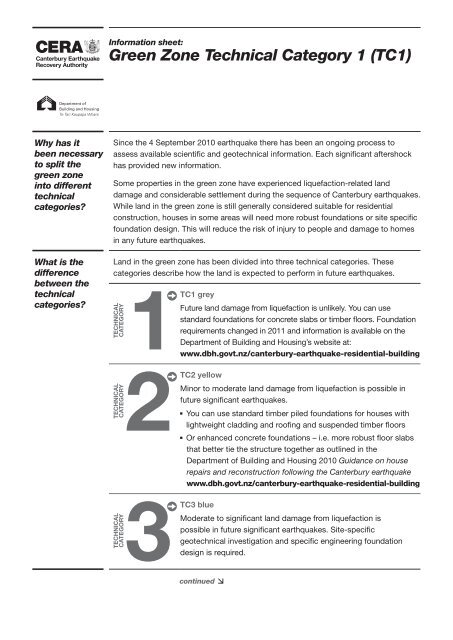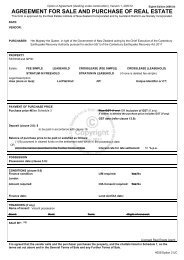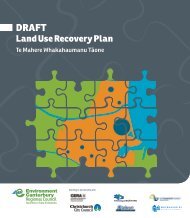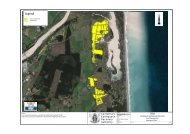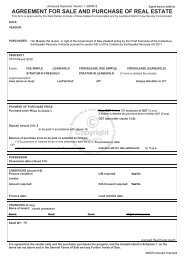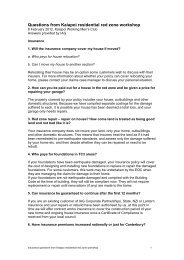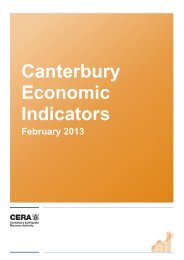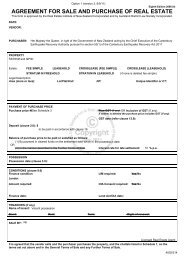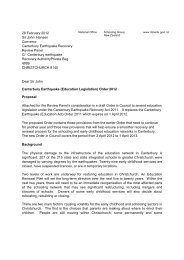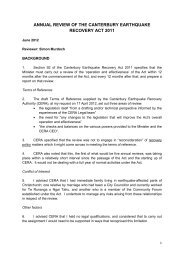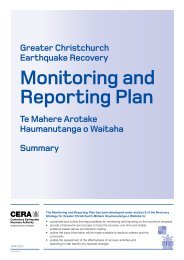Information sheet: Green Zone Technical Category 1 (TC1)
Information sheet: Green Zone Technical Category 1 (TC1)
Information sheet: Green Zone Technical Category 1 (TC1)
- No tags were found...
Create successful ePaper yourself
Turn your PDF publications into a flip-book with our unique Google optimized e-Paper software.
<strong>Information</strong> <strong>sheet</strong>:<br />
<strong>Green</strong> <strong>Zone</strong> <strong>Technical</strong> <strong>Category</strong> 1 (<strong>TC1</strong>)<br />
Why has it<br />
been necessary<br />
to split the<br />
green zone<br />
into different<br />
technical<br />
categories<br />
What is the<br />
difference<br />
between the<br />
technical<br />
categories<br />
Since the 4 September 2010 earthquake there has been an ongoing process to<br />
assess available scientific and geotechnical information. Each significant aftershock<br />
has provided new information.<br />
Some properties in the green zone have experienced liquefaction-related land<br />
damage and considerable settlement during the sequence of Canterbury earthquakes.<br />
While land in the green zone is still generally considered suitable for residential<br />
construction, houses in some areas will need more robust foundations or site specific<br />
foundation design. This will reduce the risk of injury to people and damage to homes<br />
in any future earthquakes.<br />
Land in the green zone has been divided into three technical categories. These<br />
categories describe how the land is expected to perform in future earthquakes.<br />
TECHNICAL<br />
CATEGORY<br />
<strong>TC1</strong> grey<br />
Future land damage from liquefaction is unlikely. You can use<br />
standard foundations for concrete slabs or timber floors. Foundation<br />
requirements changed in 2011 and information is available on the<br />
Department of Building and Housing’s website at:<br />
www.dbh.govt.nz/canterbury-earthquake-residential-building<br />
TECHNICAL<br />
CATEGORY<br />
TC2 yellow<br />
Minor to moderate land damage from liquefaction is possible in<br />
future significant earthquakes.<br />
You can use standard timber piled foundations for houses with<br />
lightweight cladding and roofing and suspended timber floors<br />
Or enhanced concrete foundations – i.e. more robust floor slabs<br />
that better tie the structure together as outlined in the<br />
Department of Building and Housing 2010 Guidance on house<br />
repairs and reconstruction following the Canterbury earthquake<br />
www.dbh.govt.nz/canterbury-earthquake-residential-building<br />
TECHNICAL<br />
CATEGORY<br />
TC3 blue<br />
Moderate to significant land damage from liquefaction is<br />
possible in future significant earthquakes. Site-specific<br />
geotechnical investigation and specific engineering foundation<br />
design is required.<br />
continued
<strong>Information</strong> <strong>sheet</strong>:<br />
<strong>Green</strong> <strong>Zone</strong> <strong>Technical</strong> <strong>Category</strong> 1 (<strong>TC1</strong>)<br />
What do I<br />
need to do<br />
to ensure my<br />
repairs meet<br />
Building Code<br />
requirements<br />
Homeowners whose land is in <strong>TC1</strong> can get on with repairing or rebuilding their<br />
homes. The only further site-specific geotechnical investigation required is the simple<br />
shallow soil strength testing which is standard for all homes. A range of standard<br />
solutions are available for the repair and rebuilding of foundations in these areas.<br />
New foundations<br />
If you are rebuilding your foundations, you can use standard foundations for concrete<br />
slabs and timber floors.<br />
The foundation requirements changed in 2011. Your builder or project management<br />
office can find information on the Department of Building and Housing’s website<br />
www.dbh.govt.nz/canterbury-earthquake-residential-building<br />
Repairs to foundations<br />
If you are carrying out repairs to foundations your builder or project management<br />
office is advised to consult the Department of Building and Housing’s Guidance on<br />
house repairs and reconstruction following the Canterbury earthquake.<br />
The guidance is being updated. A summary of the update, the 2010 guidance and<br />
other information is available on the Department of Building and Housing’s website<br />
www.dbh.govt.nz/canterbury-earthquake-residential-building<br />
Repairs to other areas of your home – excluding foundations<br />
If you are carrying out repairs to other areas of your home that don’t involve the<br />
foundations your builder or project management office is advised to use normal repair<br />
methods and refer to the Department of Building and Housing’s December 2010<br />
Guidance for house repairs and reconstruction following the Canterbury earthquake.<br />
The guidance is being updated and will include further information on repairs.<br />
How much are<br />
repairs to my<br />
foundations<br />
likely to cost<br />
Where can<br />
I find more<br />
information<br />
There are no additional foundation requirements for homes in <strong>Technical</strong> <strong>Category</strong> 1<br />
(<strong>TC1</strong>). Homeowners in <strong>TC1</strong> with foundations that need to be repaired or rebuilt<br />
due to earthquake damage can carry out repairs to foundations as part of their<br />
normal insurance process. Additional costs are unlikely as standard foundations<br />
are acceptable.<br />
More information is available on the Department of Building and Housing’s website at<br />
www.dbh.govt.nz/canterbury-earthquake-residential-building


